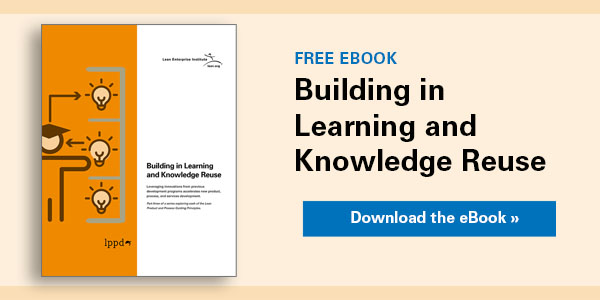Go and find the best chess player you know and challenge them to a game with the following conditions:
- Your opponent gets to move first.
- You must give up some of your pieces.
Would you bet $1,000 that you could win? Would you even be interested in playing?
What if you could move twice for every move your opponent made? Would the advantage of speed make up for your disadvantages?
At US Synthetic, we experienced the power of speed when we reduced our learning cycle time from 43 days to 4.5 days.
Rapid Learning Cycles at US Synthetic
I have spent the last 25 years working in R&D at US Synthetic, a manufacturer of synthetic diamond tools for oil and gas drilling, machining, and bearing applications. I vividly recall reading the chess game analogy in Certain to Win by Chet Richards and wondering what we could do to improve speed in product development.
This focus on rapid learning was a powerful insight that shaped my journey with lean product and process development (LPPD).
Our product development process typically involves changing the material properties of the diamond to match the requirements of our customers’ applications. Almost every new product we develop must be fabricated and tested in our lab to verify that performance matches our design targets. Our designers were often waiting for parts to be built or lab tests to complete so they could learn if their ideas worked or if they needed to try something else. I wondered what it would be like to wake up in the morning with an idea and have lab results before I went home that evening. The idea of one-day learning cycles became a simple, clear goal that we could use to drive improvement work.
Everyone wants to go ‘faster’ in development, but what does faster mean? Speed should refer to the rate at which we learn.
Allen Ward
Our first kaizen (improvement) event related to rapid learning focused on the prototype manufacturing step. At the time, highly skilled technicians would beg, borrow, and steal time on the production floor to build prototypes. The kaizen prep revealed that it took an average of 23 days to make prototype parts for testing. Simple tools like spaghetti diagrams and process flow maps showed that a dedicated prototype cell could dramatically reduce cycle time.
We cobbled together an assortment of used and unwanted machines from the production floor and built our first cell dedicated to product development. We asked some of the technicians to staff the cell full time so we could experiment with the system and measure the improvement. By the end of the kaizen event, we had reduced the turnaround time from 23 days to four days and demonstrated the value of a full-time staff. Fortunately, our current prototype cell has the same state-of-the-art machinery as our production floor, and we have been able to further reduce flow time to 1.5 days through years of ongoing PDCA.
The next area we chose to tackle was testing. Our data showed that it took an average of 20 days to complete a test once the parts were built. The kaizen team value stream mapped the testing process and identified numerous sources of waste. Why did we walk nearly five miles back and forth from the testing bay to an office to input data into a computer for each test? Why did we shut the machine down for 40 minutes each day to clean an external component? Why did it take nearly four hours to change over from one test to another? We tackled each of these issues through multiple PDCA cycles and eventually cut testing turnaround time from an average of 20 days to just three.
We have yet to achieve our goal of a one-day turnaround from idea to test, but we came remarkably close, reducing our learning cycle time from 43 days to 4.5. That is nearly ten times the learning rate. Imagine the chess game if you could move 10 times for every move of your opponent! Think about what that means to a development team. They can now learn something new 58 times a year compared to six times a year with the previous system.
Rapid Learning as a Competitive Advantage
Those of us involved in product development often face constraints like the ones in the chess example. Despite our best efforts, we are not always first to market with a new product or innovation. Our competitors may have more money, more people, and more resources working on product development than we do. Finally, the basic rule of all competition is to assume you are not smarter than your competitors (or your customers, for that matter).
Is there a general strategy we can use to overcome these disadvantages and still win? Air Force Colonel John R. Boyd was obsessed with this question. Boyd was a fighter pilot and highly influential military strategist. The F-86 he flew during the Korean War achieved a stunning ten-to-one kill ratio against the MiG-15, a far superior aircraft in many ways. The MiG-15 could make harder turns than the F-86, could accelerate and climb faster, and had better high-altitude performance. So, what happened?
The ability to operate at a faster tempo or rhythm than an adversary enables one to fold the adversary back inside himself so that he can neither appreciate nor keep up with what is going on. He will become disoriented and confused.
John Boyd
Boyd identified two subtle advantages the F-86 had over the MiG. First, the F-86 had a bubble canopy that gave the pilot a 360-degree field of vision, while the MiG pilot’s view was blocked to the rear. Second, the F-86 had full hydraulic control, allowing the pilot to transition from one maneuver to another quicker than the MiG, which did not have hydraulic controls. Boyd hypothesized that the ability to learn and adapt faster in the F-86 was the secret to its success.
Boyd’s interest went well beyond the F-86 paradox, however. His direct experience as a fighter pilot and considerable research ranging from the German Blitzkrieg of World War II to the Toyota Production System led Boyd to a breakthrough insight: we can use time as a principal strategic device.
Steven Spear makes the connection between learning rate and performance clear in The High Velocity Edge. The difference between good companies and great companies is their rate of learning. Toyota did not start out making high-quality cars at low cost. In 1965, Toyota’s productivity was about half that of GM. However, Toyota was learning how to improve quality and reduce cost at a rate about 3.5 times faster than GM so that by 1990, Toyota’s productivity was twice GM’s. Toyota and other fast learning organizations have turned their rate of learning into a sustainable competitive advantage.
If we can learn faster than our competition, we are certain to win!
Competitive advantage derives from discovering new principles, or new applications of basic principles, specific to your products and obtainable only from your experience.
Allen Ward
Unintended Consequences
Increasing our learning rate by a factor of 10 created several benefits for US Synthetic. First, we were able to test multiple parts instead of just one. Variation is a fact of life, and the only way to know the size of your measurement variation is to make repeat measurements. Being able to see the variation helped us avoid launching products that would not actually improve performance. Second, we could now use DOE (Design of Experiments) instead of One-Factor-At-A-Time experimentation to truly understand which factors improved performance. It became clear that we had multiple ways of achieving good performance. Some were more complex, costly, and of lower quality than others. The DOE results provided a rational framework for fixing the elements that did not affect performance while leaving the performance elements flexible. The quality of new products improved using this fixed-vs-flexible approach to reduce complexity and variety. Yields of new products have been greater than legacy products for the past four years!
I would like to say that is the end of the story, but the reality is a little more complex. One unintended consequence of reducing turnaround time by a factor of 10 was that it is now faster to test every new idea than to see if the data already exists. We have a gap in our ability to capture and reuse knowledge. However, I know we can close this gap with ongoing kaizen and by drawing on the LPPD community for ideas and inspiration.
Designing the Future
An Introduction to Lean Product and Process Development.






